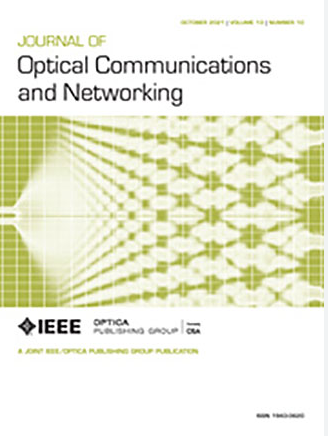用于广播和选择型空间交叉连接的全端口翻转19芯光纤分离器的设计、原型设计和极性管理
IF 4.3
2区 计算机科学
Q1 COMPUTER SCIENCE, HARDWARE & ARCHITECTURE
引用次数: 0
摘要
分层光交叉连接结合了基于空间分路复用技术的空间交叉连接(SXC)和传统波长交叉连接,可以经济地适应互联网流量的持续指数增长。SXC在路由选择配置中有一个核心选择开关(CSS)。CSS是一款基于MCF (multi-core fiber)的光交换机,无需FIFO (fan-in - fan-out)器件,可以实现单核光信号交换。为了降低SXC的成本,广播和选择(B&S)配置是有希望的,其中SXC中的入口css被MCF分离器(SPLs)取代。在本文中,我们提出了一种$ b{1} \ N$ MCF SPLs的结构,并提出了一种用于SXC时管理极性和磁芯排列翻转的方法。此外,我们报告了使用${1}\times{2}$全端口翻转19芯光纤(19-CF) SPLs构建的实验结果,以验证所提出方法的有效性。所提出的方法的独特之处在于所有MCF输出端口的核心排列相对于输入端口的排列是倒置的。这消除了在B&S SXC的出口CSS中发生的核心排列翻转。此外,基于与具有极性的基于MCF的光学器件(如CSS和FIFO)的比较,我们澄清了MCF SPLs没有极性,类似于MCF跳线。因此,可以使用单一类型的MCF SPL而不用担心方向。三个构建的全端口反转的${1}\倍{2}$ 19-CF SPL原型在c波段表现出低损耗(${\lt}{7.5}\;{\rm dB}$),低偏振相关损耗(${\lt}{0.5}\;{\rm dB}$)和低总核间串扰(${\lt}{-}35.7\;{\rm dB}$)。此外,当基于100 gb /s的波分复用信号输入到所有核时,没有观察到光信噪比损失。最后,我们证明了通过在树形结构中连接三个全端口翻转的${1}\times {2}$ 19-CF SPL,可以构造一个全端口非翻转的${1}\times {4}$ 19-CF SPL。本文章由计算机程序翻译,如有差异,请以英文原文为准。
Design, prototyping, and polarity management of all-port flipped 19-core fiber splitters for broadcast-and-select-type spatial cross-connects
A hierarchical optical cross-connect that combines a spatial cross-connect (SXC) based on spatial division multiplexing technology with a conventional wavelength cross-connect can economically accommodate the continuing exponential growth in Internet traffic. The SXC has a core selective switch (CSS) in a route-and-select configuration. The CSS is a multi-core fiber (MCF)-based optical switch that can switch optical signals on a per-core basis without going through fan-in fan-out (FIFO) devices. To reduce the cost of the SXC, a broadcast-and-select (B&S) configuration is promising, where the ingress CSSs in the SXC are replaced by MCF splitters (SPLs). In this paper, we propose a construction for ${1} \times N$ MCF SPLs and a method to manage the polarity and core arrangement flipping when using them for the SXC. In addition, we report experimental results using ${1} \times {2}$ all-port flipped 19-core fiber (19-CF) SPLs constructed to verify the effectiveness of the proposed method. The unique feature of the proposed method is that the core arrangement of all MCF output ports is inverted with respect to that of the input port. This cancels the core arrangement flipping that occurs in the egress CSS in the B&S SXC. Furthermore, based on a comparison with MCF-based optical devices, such as the CSS and FIFO, which have polarity, we clarify that MCF SPLs have no polarity, similar to MCF patch cords. Therefore, a single type of MCF SPL can be used without worrying about orientation. Three constructed all-port-reversed ${1} \times {2}$ 19-CF SPL prototypes exhibit low loss (${\lt}{7.5}\;{\rm dB}$ ), low polarization-dependent loss (${\lt}{0.5}\;{\rm dB}$ ), and low total inter-core cross talk (${\lt} {-}35.7\;{\rm dB}$ ) at C-band wavelengths. In addition, no optical signal-to-noise ratio penalty is observed when 100-Gb/s-based wavelength-division-multiplexed signals are input to all cores. Finally, we show that an all-port non-flipped ${1} \times {4}$ 19-CF SPL can be constructed by connecting three all-port flipped ${1} \times {2}$ 19-CF SPLs in a tree structure.
求助全文
通过发布文献求助,成功后即可免费获取论文全文。
去求助
来源期刊
CiteScore
9.40
自引率
16.00%
发文量
104
审稿时长
4 months
期刊介绍:
The scope of the Journal includes advances in the state-of-the-art of optical networking science, technology, and engineering. Both theoretical contributions (including new techniques, concepts, analyses, and economic studies) and practical contributions (including optical networking experiments, prototypes, and new applications) are encouraged. Subareas of interest include the architecture and design of optical networks, optical network survivability and security, software-defined optical networking, elastic optical networks, data and control plane advances, network management related innovation, and optical access networks. Enabling technologies and their applications are suitable topics only if the results are shown to directly impact optical networking beyond simple point-to-point networks.

 求助内容:
求助内容: 应助结果提醒方式:
应助结果提醒方式:


